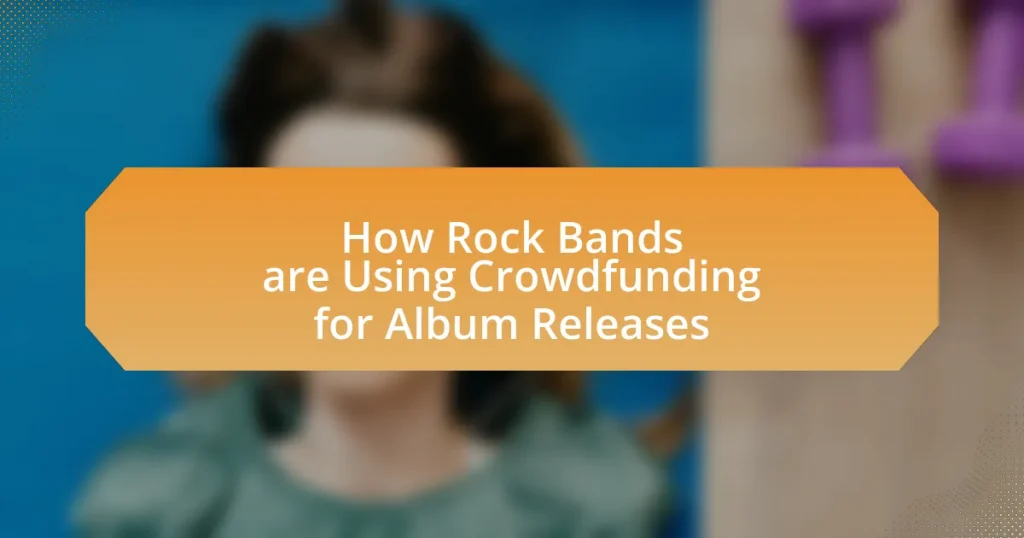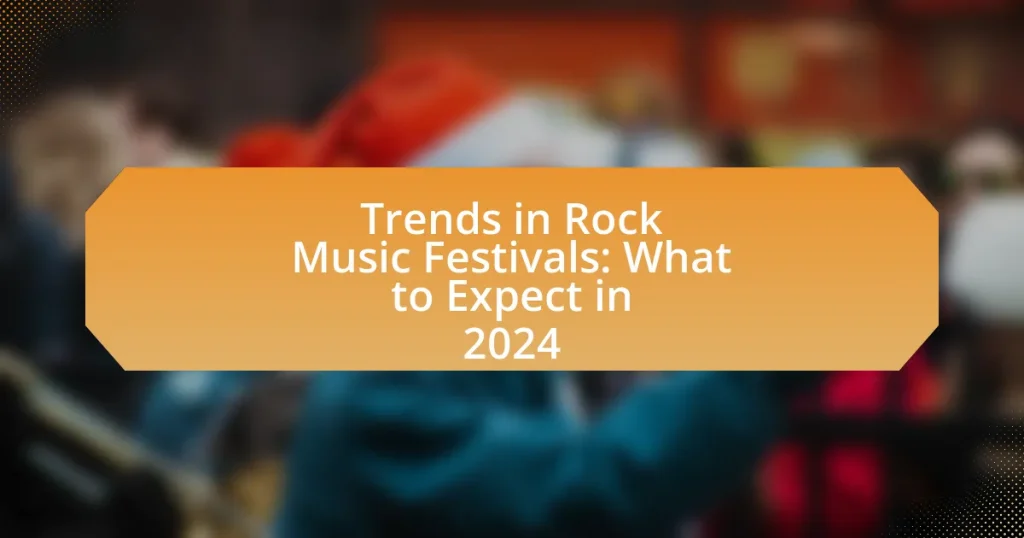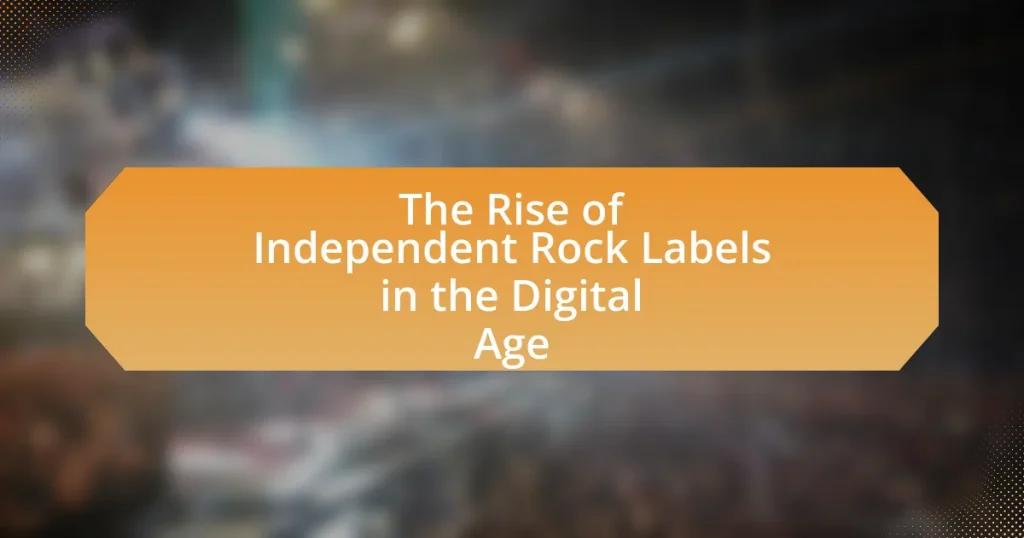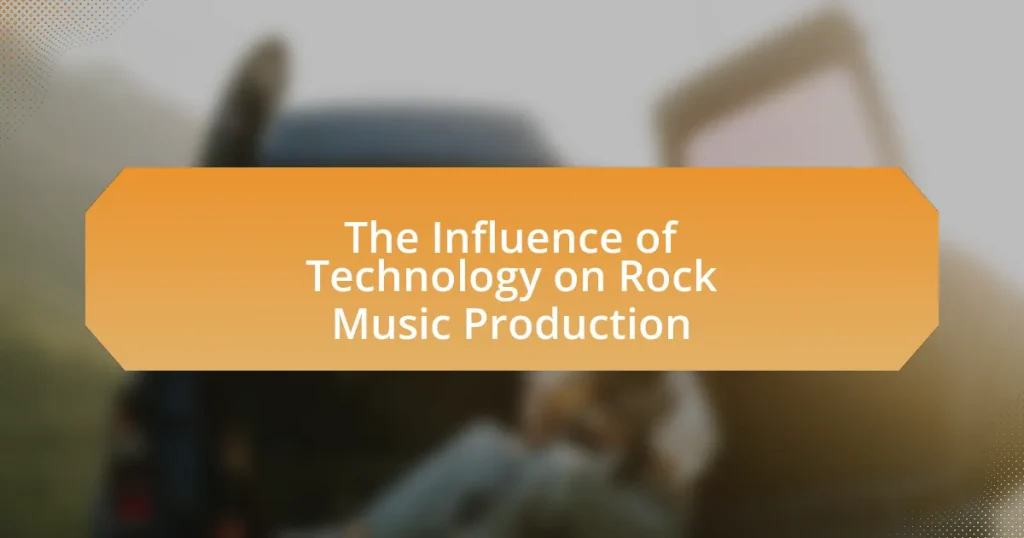Rock bands are increasingly turning to crowdfunding as a means to finance their album releases, utilizing platforms such as Kickstarter, Indiegogo, and Patreon. This approach allows artists to engage directly with their fan base, retain creative control, and bypass traditional record label financing. The article explores the various crowdfunding platforms available, the strategies bands employ to successfully raise funds, the benefits of direct fan engagement, and the challenges they face in this competitive landscape. Additionally, it highlights case studies of successful campaigns and outlines best practices for managing crowdfunding efforts effectively.
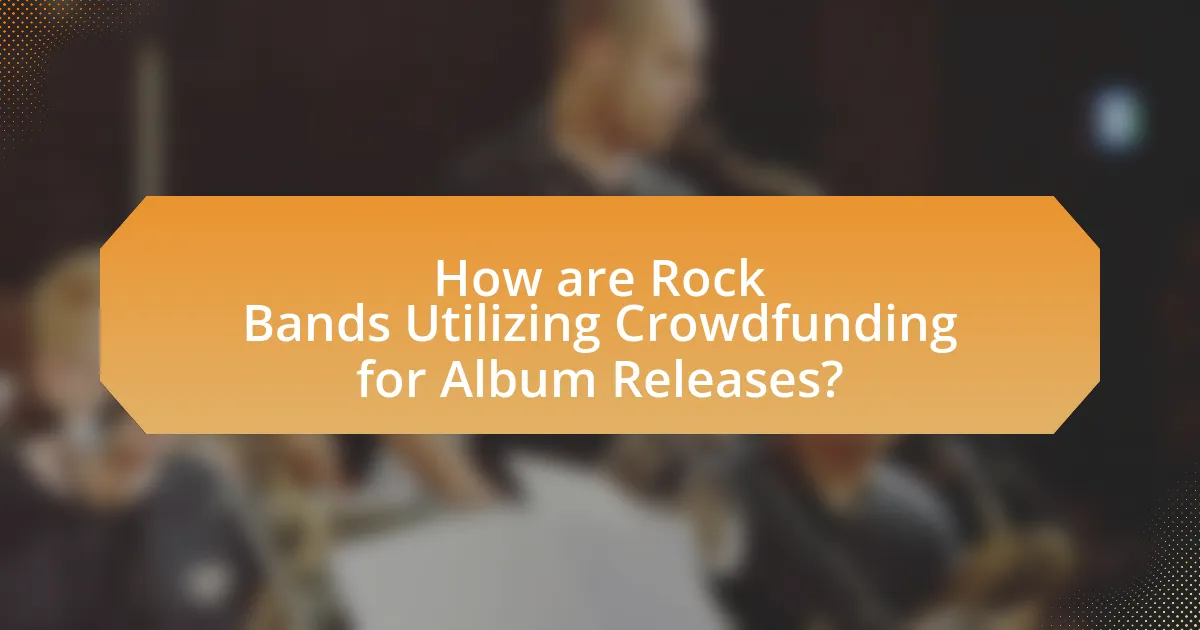
How are Rock Bands Utilizing Crowdfunding for Album Releases?
Rock bands are utilizing crowdfunding for album releases by engaging their fan base to raise funds directly through platforms like Kickstarter and Indiegogo. This approach allows bands to bypass traditional record label financing, enabling them to retain creative control and ownership of their music. For instance, in 2012, the band Amanda Palmer raised over $1.2 million on Kickstarter for her album “Theatre Is Evil,” demonstrating the potential of crowdfunding to exceed financial goals significantly. Additionally, crowdfunding campaigns often include tiered rewards for backers, such as exclusive merchandise or private concerts, which incentivizes fans to contribute. This model not only secures funding but also fosters a deeper connection between artists and their supporters.
What are the primary crowdfunding platforms used by rock bands?
The primary crowdfunding platforms used by rock bands are Kickstarter, Indiegogo, and Patreon. Kickstarter is widely recognized for its all-or-nothing funding model, which encourages bands to set specific funding goals for their album projects. Indiegogo offers flexible funding options, allowing bands to keep whatever funds they raise, regardless of whether they meet their goal. Patreon, on the other hand, enables bands to build ongoing relationships with fans through subscription-based support, providing a steady income stream for album production and other projects. These platforms have been instrumental in helping rock bands finance their music and engage with their fanbase directly.
How do these platforms differ in terms of features and audience?
Crowdfunding platforms for rock bands differ significantly in features and audience. For instance, Kickstarter offers an all-or-nothing funding model, appealing to creators who want to ensure full project funding before proceeding, while Indiegogo provides flexible funding options, attracting a broader range of projects and audiences. Additionally, Patreon focuses on subscription-based funding, catering to artists seeking ongoing support from dedicated fans. These differences in funding structures and target audiences influence how rock bands engage with their supporters and the types of projects they can successfully fund.
What are the fees associated with these crowdfunding platforms?
Crowdfunding platforms typically charge fees ranging from 5% to 10% of the total funds raised. For instance, Kickstarter charges a 5% fee on the total amount collected, while Indiegogo’s fees can vary, with a standard fee of 5% and additional payment processing fees that can add another 3% to 5%. These fees are deducted from the funds before they are disbursed to the project creators. This fee structure is designed to cover operational costs and payment processing services, ensuring that the platforms can continue to function effectively.
Why are rock bands turning to crowdfunding instead of traditional funding methods?
Rock bands are turning to crowdfunding instead of traditional funding methods primarily due to the direct financial support it offers from fans, which reduces reliance on record labels and banks. This shift allows bands to maintain creative control and engage their audience more intimately, as platforms like Kickstarter and Indiegogo enable them to raise funds directly from supporters who are invested in their success. For instance, in 2012, the band Amanda Palmer raised over $1.2 million on Kickstarter, demonstrating the potential of crowdfunding to surpass traditional funding avenues.
What challenges do rock bands face with traditional funding?
Rock bands face significant challenges with traditional funding, primarily due to limited access to financial resources and high competition for funding opportunities. Traditional funding sources, such as record labels and banks, often require established track records or collateral, which many emerging bands lack. Additionally, the music industry has shifted towards digital platforms, making it harder for bands to secure traditional funding as investors may prioritize more lucrative, tech-driven ventures. According to a 2020 report by the Music Industry Research Association, 70% of independent artists reported difficulties in obtaining funding through conventional means, highlighting the systemic barriers they encounter.
How does crowdfunding provide a solution to these challenges?
Crowdfunding provides a solution to the financial challenges faced by rock bands during album releases by enabling them to raise funds directly from their fan base. This model allows bands to bypass traditional funding sources, such as record labels or banks, which often impose strict requirements and lengthy approval processes. For instance, a study by the University of Southern California found that successful crowdfunding campaigns can raise significant amounts, with some bands securing over $100,000 for their projects. This direct engagement not only secures necessary funds but also fosters a sense of community and loyalty among fans, as they feel invested in the band’s success.
What strategies do rock bands employ to successfully crowdfund their albums?
Rock bands employ several strategies to successfully crowdfund their albums, including building a strong fanbase, offering enticing rewards, and utilizing social media for promotion. A strong fanbase ensures that there is a dedicated audience willing to support the project financially. Offering rewards, such as exclusive merchandise or behind-the-scenes access, incentivizes fans to contribute more. Additionally, effective use of social media platforms allows bands to reach a wider audience, engage with fans, and create buzz around the crowdfunding campaign. These strategies have been validated by successful campaigns, such as those on platforms like Kickstarter and Indiegogo, where bands have raised significant funds by implementing these methods.
How important is fan engagement in the crowdfunding process?
Fan engagement is crucial in the crowdfunding process, as it directly influences the success of funding campaigns. Engaged fans are more likely to contribute financially, share the campaign with their networks, and promote the project on social media. For instance, a study by the University of Southern California found that campaigns with higher fan engagement levels raised 50% more funds than those with lower engagement. This demonstrates that active participation and communication with fans can significantly enhance the likelihood of reaching funding goals in crowdfunding initiatives for rock bands.
What types of rewards do bands offer to incentivize backers?
Bands offer various rewards to incentivize backers, including exclusive merchandise, early access to music, personalized experiences, and special recognition. Exclusive merchandise often includes limited edition vinyl records, T-shirts, or posters that are not available to the general public, creating a sense of uniqueness for backers. Early access to music allows supporters to listen to new tracks before their official release, enhancing their connection to the band. Personalized experiences can range from private concerts to meet-and-greet opportunities, providing fans with memorable interactions. Special recognition may involve naming backers in album credits or on the band’s website, acknowledging their support publicly. These reward types are designed to foster a deeper relationship between the band and its supporters, ultimately driving successful crowdfunding campaigns.
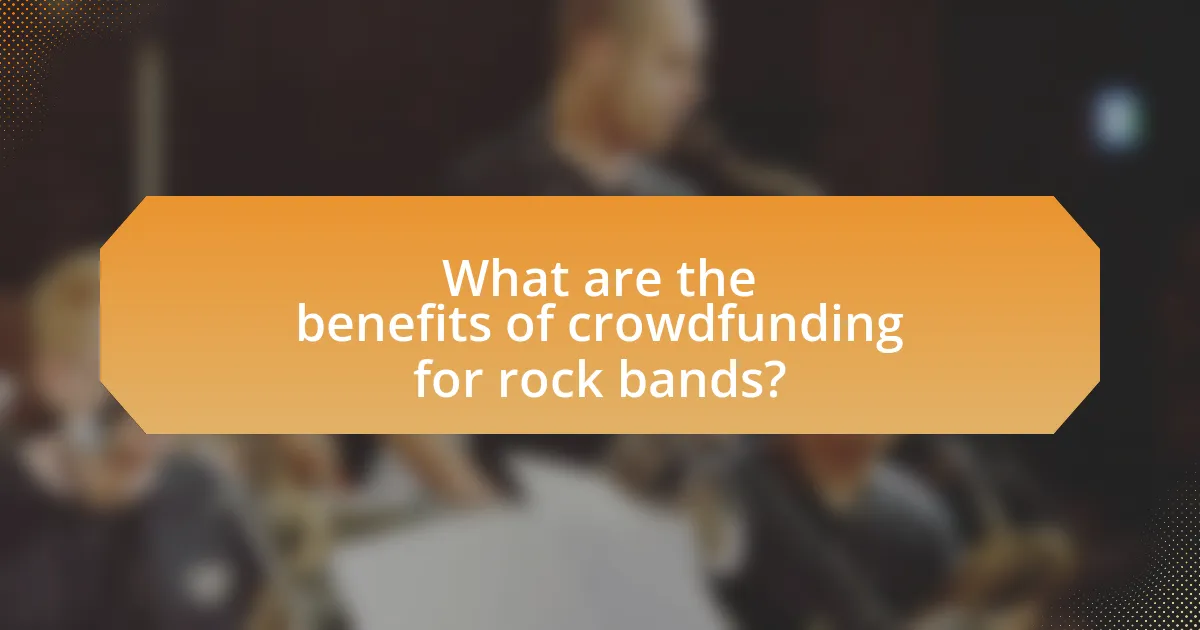
What are the benefits of crowdfunding for rock bands?
Crowdfunding provides rock bands with essential financial support, enabling them to produce albums without relying on traditional record labels. This funding model allows bands to gauge audience interest and build a dedicated fanbase before releasing their music. For instance, successful campaigns on platforms like Kickstarter have raised significant amounts, with some bands securing over $100,000 for album production, demonstrating the viability of this approach. Additionally, crowdfunding fosters direct engagement with fans, creating a sense of community and loyalty, which can lead to increased ticket sales and merchandise revenue.
How does crowdfunding enhance fan relationships?
Crowdfunding enhances fan relationships by fostering direct engagement and collaboration between rock bands and their supporters. This financial model allows fans to contribute to album production, creating a sense of ownership and investment in the music. For instance, when bands use platforms like Kickstarter or Indiegogo, they often offer exclusive rewards, such as behind-the-scenes content or personalized merchandise, which strengthens the emotional connection between the artists and their fans. Research indicates that campaigns with interactive elements, such as updates and fan feedback, lead to higher satisfaction and loyalty among supporters, reinforcing the bond between the band and its audience.
What role does community building play in a successful campaign?
Community building is essential for a successful campaign as it fosters engagement, loyalty, and support among fans. When rock bands cultivate a strong community, they create a network of dedicated supporters who are more likely to contribute to crowdfunding efforts. Research indicates that campaigns with an established community can raise up to 50% more funds than those without, as fans feel a personal connection and investment in the band’s success. This connection enhances communication, encourages sharing of the campaign, and ultimately leads to a higher likelihood of reaching funding goals.
How can crowdfunding lead to increased album sales post-release?
Crowdfunding can lead to increased album sales post-release by creating a dedicated fanbase that feels invested in the project. When fans contribute financially to an album’s production, they often become more engaged and motivated to support the album’s success, resulting in higher sales. For instance, a study by the University of Southern California found that artists who successfully crowdfund their projects see a 30% increase in sales compared to those who do not utilize crowdfunding. This engagement can manifest in fans promoting the album through word-of-mouth and social media, further amplifying its reach and sales potential.
What financial advantages does crowdfunding provide?
Crowdfunding provides rock bands with immediate access to capital without the need for traditional loans or investors. This financial model allows bands to raise funds directly from their fanbase, often resulting in lower financial risk and greater control over their projects. For instance, a study by the University of Cambridge found that crowdfunding can lead to a 30% increase in funding success for creative projects compared to conventional methods. Additionally, crowdfunding platforms often charge lower fees than banks or investors, further enhancing the financial benefits for bands seeking to finance album releases.
How does crowdfunding reduce financial risk for bands?
Crowdfunding reduces financial risk for bands by allowing them to secure funding directly from fans before incurring production costs. This model shifts the financial burden away from the band, as they can gauge interest and receive upfront capital to cover expenses such as recording, marketing, and distribution. For instance, a successful crowdfunding campaign can raise thousands of dollars, enabling bands to produce their albums without the need for traditional loans or record label advances, which often come with high-interest rates and contractual obligations. This approach not only minimizes the risk of financial loss but also fosters a direct connection between the band and its supporters, ensuring that the project has a built-in audience before it even launches.
What are the potential earnings from a successful crowdfunding campaign?
The potential earnings from a successful crowdfunding campaign can range significantly, often between $10,000 to over $1 million, depending on factors such as the project’s scope, the band’s fanbase, and the campaign’s marketing strategy. For instance, successful campaigns by rock bands like Amanda Palmer raised over $1.2 million, showcasing the high earning potential when engaging a dedicated audience. Additionally, statistics indicate that the average successful crowdfunding campaign raises approximately $7,000, highlighting the financial viability for many artists in the music industry.
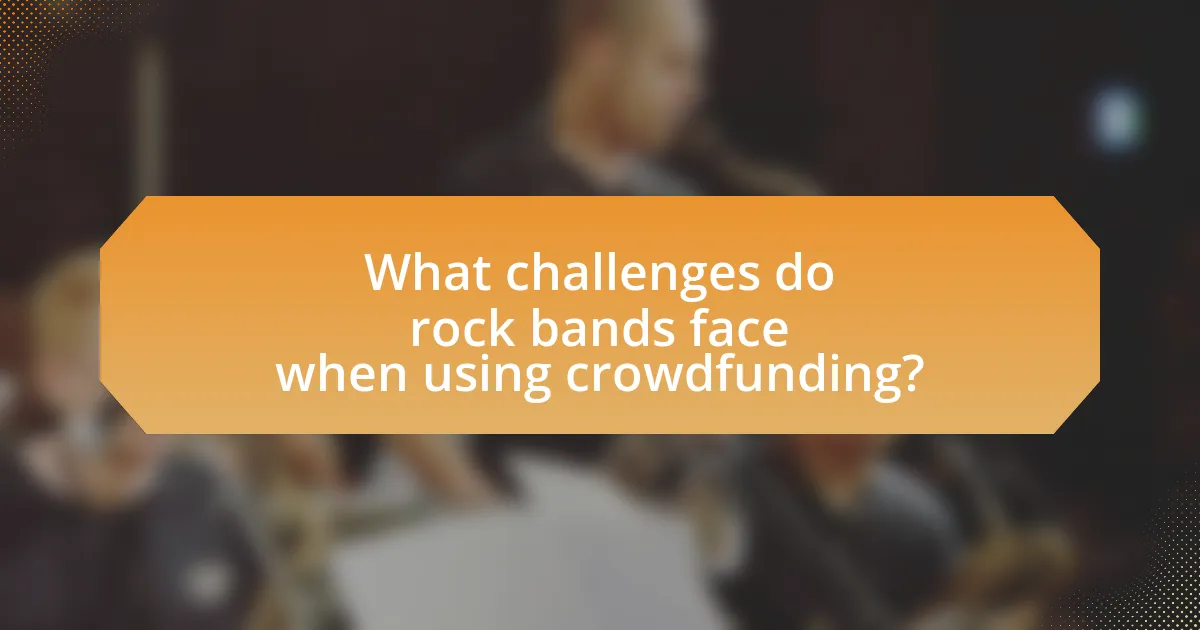
What challenges do rock bands face when using crowdfunding?
Rock bands face several challenges when using crowdfunding, including competition for attention, the need for effective marketing, and the risk of not meeting funding goals. The competitive landscape is significant, as numerous projects vie for the same pool of potential backers, making it difficult for individual bands to stand out. Effective marketing strategies are essential; bands must engage their audience through social media and other channels to drive interest and support. Additionally, if a band fails to reach its funding target, they may not receive any of the pledged funds, which can hinder their ability to produce the album. According to a study by the University of Southern California, only about 36% of music crowdfunding campaigns successfully reach their funding goals, highlighting the difficulties bands encounter in this space.
What common pitfalls should bands avoid during their campaigns?
Bands should avoid overpromising rewards during their crowdfunding campaigns. When bands set unrealistic expectations for backers, such as offering extensive merchandise or exclusive experiences that they cannot deliver, it can lead to disappointment and damage their reputation. A study by the University of Pennsylvania found that campaigns with clear, achievable goals and realistic reward structures are more likely to succeed, as they foster trust and satisfaction among backers. Additionally, bands should not neglect communication; failing to keep backers updated can result in a loss of support and engagement.
How can poor marketing impact a crowdfunding effort?
Poor marketing can significantly hinder a crowdfunding effort by failing to attract potential backers. When rock bands do not effectively communicate their project’s value or engage their target audience, they risk low visibility and reduced funding. For instance, a study by the University of Pennsylvania found that campaigns with strong marketing strategies raised 50% more funds than those with weak marketing efforts. This demonstrates that without a solid marketing plan, a crowdfunding initiative may struggle to gain traction, ultimately leading to insufficient financial support for the album release.
What are the consequences of setting unrealistic funding goals?
Setting unrealistic funding goals can lead to significant negative consequences for rock bands using crowdfunding for album releases. These consequences include diminished credibility, as backers may perceive the band as unprofessional or out of touch with their financial needs. Additionally, failing to meet funding goals can result in wasted time and resources, as bands invest effort into campaigns that do not yield the necessary support. Research indicates that campaigns with overly ambitious targets often see lower overall funding success rates, as potential backers may be deterred by the perceived unlikelihood of reaching such goals. This can ultimately harm the band’s reputation and future fundraising efforts, making it crucial for bands to set achievable and realistic funding targets.
How can bands effectively manage their crowdfunding campaigns?
Bands can effectively manage their crowdfunding campaigns by setting clear goals, engaging their audience, and providing compelling rewards. Clear goals help define the financial target and timeline, which can motivate backers. Engaging the audience through regular updates and personal stories fosters a connection, encouraging more contributions. Additionally, offering attractive rewards, such as exclusive merchandise or experiences, can incentivize higher pledges. Research indicates that campaigns with well-defined goals and active communication can raise up to 50% more funds than those without these strategies.
What tools and resources are available for campaign management?
Campaign management for crowdfunding in the context of rock bands involves several tools and resources designed to streamline the process. Key tools include platforms like Kickstarter and Indiegogo, which provide a framework for creating and managing campaigns, including features for setting funding goals, tracking progress, and engaging with backers. Additionally, social media management tools such as Hootsuite and Buffer help bands promote their campaigns across various platforms, while email marketing services like Mailchimp facilitate direct communication with supporters. Analytics tools, such as Google Analytics, allow bands to monitor traffic and engagement metrics, ensuring they can adjust their strategies effectively. These resources collectively enhance the efficiency and effectiveness of campaign management in crowdfunding scenarios.
How important is communication with backers throughout the campaign?
Communication with backers throughout the campaign is crucial for maintaining trust and engagement. Effective communication fosters a sense of community and keeps backers informed about project progress, which can lead to increased support and potential future funding. Research indicates that campaigns with regular updates and transparent communication are 50% more likely to reach their funding goals, as backers feel more connected and invested in the project’s success.
What are the best practices for a successful crowdfunding campaign?
The best practices for a successful crowdfunding campaign include setting a clear funding goal, creating an engaging campaign page, and actively promoting the campaign. A clear funding goal helps backers understand the financial needs of the project, while an engaging campaign page with compelling visuals and storytelling captures attention and encourages contributions. Active promotion through social media, email newsletters, and community engagement increases visibility and attracts potential backers. According to a study by Indiegogo, campaigns that effectively communicate their story and engage with their audience raise 50% more funds than those that do not.
How can bands create compelling campaign videos and descriptions?
Bands can create compelling campaign videos and descriptions by focusing on storytelling, authenticity, and visual appeal. Effective storytelling engages the audience emotionally, allowing bands to share their journey, inspirations, and the purpose behind their crowdfunding campaign. Authenticity builds trust; bands should present their true selves and connect with fans on a personal level. High-quality visuals, including well-shot footage and professional editing, enhance the overall impact of the video, making it more likely to capture attention.
Research indicates that campaigns with engaging videos can increase funding success rates significantly; for instance, Kickstarter reports that projects with videos raise 50% more funds than those without. By combining these elements, bands can effectively communicate their vision and motivate fans to support their album releases through crowdfunding.
What strategies can be used to maintain momentum during the campaign?
To maintain momentum during a crowdfunding campaign for album releases, rock bands can implement regular updates and engage with their audience through social media. Regular updates keep backers informed about progress and milestones, fostering a sense of community and involvement. Engaging with the audience on platforms like Instagram and Twitter allows bands to share behind-the-scenes content, which can generate excitement and encourage sharing among fans. Additionally, offering limited-time rewards or stretch goals can incentivize contributions and create urgency, driving further engagement. Research indicates that campaigns with consistent communication and active community engagement tend to exceed their funding goals, highlighting the effectiveness of these strategies.
What lessons can be learned from successful crowdfunding campaigns in the rock genre?
Successful crowdfunding campaigns in the rock genre demonstrate the importance of building a strong community and engaging with fans. Rock bands that effectively communicate their vision and involve supporters in the creative process tend to achieve higher funding goals. For instance, campaigns like those of the band “The Decemberists” raised over $300,000 by offering exclusive rewards and maintaining transparency about their project. Additionally, leveraging social media platforms to promote campaigns and share updates fosters a sense of belonging among fans, which can significantly boost contributions. These strategies highlight that successful crowdfunding relies on fan engagement, clear communication, and a well-structured reward system.
What case studies exemplify effective crowdfunding strategies?
One prominent case study exemplifying effective crowdfunding strategies in the context of rock bands is the campaign by the band “Veruca Salt,” which successfully raised over $200,000 on PledgeMusic for their album “Ghost Notes.” This campaign demonstrated effective engagement with fans through exclusive content and personalized rewards, leading to a strong community response. Another notable example is “Amanda Palmer,” who raised over $1.2 million on Kickstarter for her album “Theatre Is Evil,” showcasing the power of direct fan interaction and the ability to leverage social media for outreach. These case studies illustrate how targeted engagement and community building can lead to successful crowdfunding outcomes in the music industry.
How can these lessons be applied to future campaigns?
The lessons learned from previous crowdfunding campaigns can be applied to future campaigns by implementing targeted marketing strategies, engaging with fans early, and setting realistic funding goals. For instance, successful campaigns often utilized social media platforms to create buzz and foster community, which can be replicated to enhance visibility and support. Additionally, analyzing past campaign data reveals that bands that offered unique rewards, such as exclusive content or experiences, achieved higher funding success rates. By applying these proven tactics, future campaigns can increase their chances of reaching funding goals and building a loyal fanbase.
